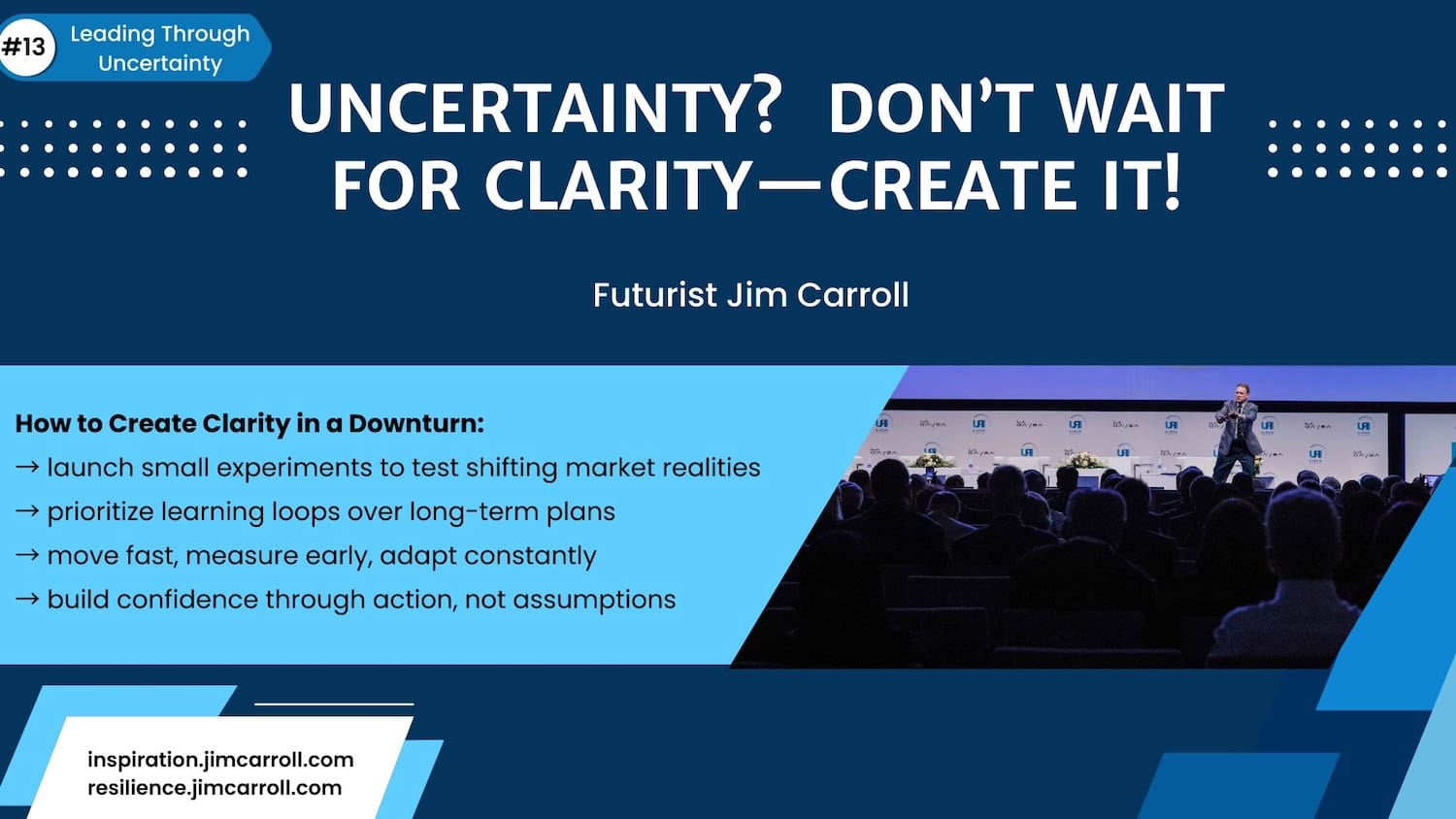"Uncertainty? Don't wait for clarity —create it!" - Futurist Jim Carroll

Futurist Jim Carroll has been writing a series on how to lead through uncertainty, sharing concepts of innovation and forward-oriented thinking in times of economic volatility. Much of it is drawn from insight he gained while speaking at leadership meetings in the wake of the 2001, ’08, and economic downturns. The series is at post #13 and will run to #20 over the next week and a bit.
In a downturn, experimentation isn’t risky. It’s responsible - because it helps to build some clarity where often that clarity does not yet exist.
That doesn't seem intuitive. In uncertain times, it’s easy to assume that clarity comes from caution - that the path forward will emerge once the noise dies down, once the data stabilizes, and once the market settles. You end up waiting a long time for that! You end up waiting for clarity that never comes, because here’s the truth: clarity doesn’t arrive. It’s earned.
And the way you earn it—especially in a downturn—is by moving. Testing. Learning. Iterating. Acting. Trying ideas to see what works. Doing things for the sake of doing, not necessarily for the big win, but to figure out what works, and what does not. And in doing so, you create your sense of clarity. That’s how you cut through the fog. That’s how you avoid paralysis.
That’s how you lead.
Experiments are your edge in an era of uncertainty because they are fuel to ignite clarity that is otherwise missing. Remember what I've said in this series - in times of economic pressure, many organizations retreat into stasis They pause product launches, cancel initiatives, and wait for signals. But the companies that thrive in a downturn do the opposite: They turn uncertainty into a laboratory. They run small tests. They build fast prototypes. They launch controlled rollouts. They create momentum—and clarity—through movement.
That’s not reckless. It’s responsible. And it builds something more valuable than predictions or plans: experiential capital.
Remember that? I keep pointing it out because it is one of the most important yet rarely recognized assets that you have, and it isn't even on your balance sheet! It's the practical insight and organizational confidence that only comes from doing. It’s what you gain every time you try something new, even if it doesn’t work. It’s what helps your team operate with speed and resilience when things are still volatile. It’s the single most valuable currency in a future defined by disruption. And it's even more valuable in a time of uncertainty with a lack of clarity - because it gets you on the path to building your clarity. You build it by testing, launching, measuring, adapting—and trying again.
Here's the thing - history is full of examples of companies that chased 'experiential capital' through small projects and fast prototypes during previous periods of economic decline. The fact is, they prototyped their way out of crisis—and that’s what made all the difference.
- Amazon: they launched AWS and expanded Kindle during two major downturns by testing small concepts that scaled with customer response. Today, both are billion-dollar pillars of their business.
- Netflix: They tested early streaming in a cautious market. Iterated their platform and content model quietly until they were ready to lead. Streaming wasn’t a leap—it was a series of calculated trials.
- LEGO: They turned near-bankruptcy in the downturn of 2001 to explosive growth by crowdsourcing new ideas, experimenting with themed kits, and embracing fast product testing.
- Procter & Gamble: They ran micro-experiments during the 'Great Recession' of 2008 to adjust pricing, formats, and distribution. They didn’t pause marketing—they tested smarter ways to deliver value.
- Adobe: They shifted from boxed software to SaaS ('software as a service') by prototyping Creative Cloud with a limited user base, tweaking based on feedback, and gradually scaling -- all while the after-effects of the 2008 downturn were raging all around them.
Each of these companies succeeded not by waiting for clarity, but by creating it through action. Through short, sharp shocks of action. You need to do that, because as I've said before - the future doesn’t wait—and neither should you. In an economy where speed trumps certainty, your competitive advantage comes from what you’ve tried, not what you’ve talked about.
Here’s how you start building that advantage now:
- launch a live test. Choose one customer segment. Try something new. Measure real results.
- prototype under pressure. Push a rough idea into the market. Let feedback shape the next version.
- accelerate learning loops. Replace long planning cycles with fast experiments. Learn weekly, not quarterly.
- capture insight. Build a shared learning bank. Don’t waste failure—mine it for gold.
- empower your team to try. Make experimentation safe. Celebrate effort, not just outcomes.
- rush something forward. It doesn’t have to be perfect—just real. Let motion build momentum.
- track what works. Treat every test as a data generator. Use outcomes to refine, redirect, and repeat.
- build a culture of motion. Innovation isn’t a project. It’s a mindset. You build it by doing.
Use urgency as fuel. In the face of hesitation, push forward. Action reveals what planning can’t. Make experiential capital your strategy. In a world that punishes delay, the most learned win.
- small bets.
- fast feedback.
- clear learning.
- scaled results.
You don’t get clarity by standing still. You create it through motion.
Every prototype, every rollout, every bold test gives you a sharper lens on what works—and what comes next.
Futurist Jim Carroll believes that the secret to much success lies in the idea of short, sharp shocks of action.

